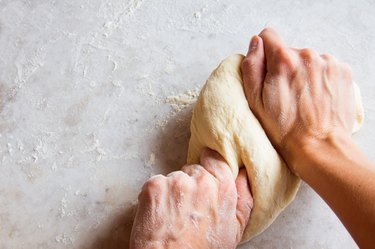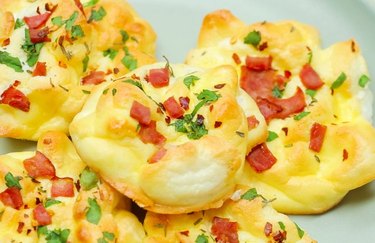
Generally speaking, tomatoes and red apples look vaguely similar, right? They're both red, round fruits that are healthy additions to any diet. But if you're expecting a crisp, sweet apple and bite into a tomato, you'll be sorely disappointed.
Yeast and baking powder act the same way: The two ingredients look pretty similar and serve the same general purpose in baking (they may even sit on the same shelf in your fridge) but they can't be used interchangeably.
Video of the Day
Video of the Day
Baking Powder vs. Yeast: What's the Difference?
Although both baking powder and yeast are ingredients often used in baking, they aren't the same. Baking powder is a chemical leavening agent, whereas yeast is a live, single-celled organism, Tracy Wilk, lead chef at the Institute of Culinary Education, explains.
Yeast also comes in different forms, including active, dry and instant (aka fresh), Wilk says. The ingredient is also used in the fermentation process for wine or beer, according to the USDA.
Both baking powder and yeast help give baked goods that rise — but the process by which they do so is different.
When added to a recipe, baking powder releases carbon dioxide gas through the dough, causing the food to puff up, according to the Science of Cooking.
On the other hand, yeast feeds on the sugars in the flour, release carbon dioxide in the process, which then causes the food to rise. Both processes release carbon dioxide to lighten the dough but yeast is much slower and leaves a distinct flavor and smell.
The Takeaway
Yeast and baking powder both cause baked goods to rise by releasing carbon dioxide. But while yeast is a live organism that ferments food, baking powder is a chemical-based ingredient. Bottom line: Stick with what your recipe calls for.
Swapping Baking Powder and Yeast
If you want your recipe to be a success, you'll want to avoid using these two ingredients interchangeably. As their function, process and composition is pretty different, they won't affect your food in the same way and should be seen as two separate ingredients completely, Wilk says.
The two ingredients don't only work differently but they're used in different types of recipes, too. While baking powder is used in most baked goods, including cookies, cakes or muffins, Wilk explains, yeast is used mostly for breads, including white bread, whole wheat, brioche and rye.
Planning to bake bread but short on yeast? You can't swap with baking powder but you can explore other recipes, Wilke recommends. "I would say try to make do with what you do have," she says. "You can make some quick breads, like biscuits or banana bread if you only have baking powder or baking soda."
A Yeast- and Baking Powder-Free Recipe
Try this yeast and baking-powder-free free cloud bread recipe next time you're short on ingredients but itching to bake.
Breakfast Cloud Bread

- Calories: 97
- Protein: 6 grams
Often associated with its low carb count, cloud bread takes only about a half-hour to prepare and doesn't require yeast, baking powder or baking soda to make the bread rise, relying instead on egg whites for the puffy, light texture
Unlike most breads or baked goods, this cloud bread is also a good source of protein and healthy fat, which means it will help keep you satiated through your morning. Pair this bread with some fresh veggies for extra fiber, or eat it on-the-go as a satiating snack.
Get the Breakfast Cloud Bread recipe and nutrition info here.